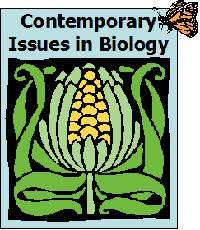
Week 14, Chapter 11 -- Freelance Writer Sample Answer
Course home | Weekly schedule | Announcements | Instructor Info | Desire2Learn | MasteringBiology® | Honor Code | FAQs | HELP!
 |
Week 14, Chapter 11 -- Freelance Writer Sample AnswerCourse home | Weekly schedule | Announcements | Instructor Info | Desire2Learn | MasteringBiology® | Honor Code | FAQs | HELP! |
Note: This sample illustrates the type of text we are looking for; you should add an external reference and follow the other formatting instructions as specified in the assignment.
This is the plot of a science fiction movie based on the selective breeding of humans. It takes place in the future.
In the year 2215, scientists interested in track and field wondered whether they could change the way people run. The traditional upright running posture seemed ungainly and inefficient, and they couldn’t find many examples of other animals that run on two legs. “Look at cheetahs,” they said. “Those things never stand up when they run.”
They thought to themselves: “What if we could breed humans to run on all fours, like a cheetah? People like that should be a lot faster than we are now.”
They knew that what they were proposing to do was unethical. After all, it had been nearly 100 years since the eugenics movement, in which the government forcibly sterilized individuals deemed “unfit” to breed. So they decided to proceed in secret.
First, they needed a lot of genetically variable kids. So they convinced poverty-stricken parents to give up their infant children, in exchange for money and the promise that their children – or perhaps their descendants – might become champion sprinters. (They forgot to mention to the parents that breeding for new varieties takes many generations).
They received generous (but clandestine) funding from major athletic shoe companies, who reasoned that selling shoes in “quads” instead of pairs would be good for business. The scientists then raised the children to walk – and run – on all fours. They organized periodic races, and the fastest girls and boys were given special training and extra privileges.
Eventually, this first generation of children grew into adults. The scientists, who were growing old themselves by then, only allowed the fastest runners to breed. They trained all of the slower ones in the science of artificial selection, so they could continue the experiment after the original scientists were gone. (Of course, those slower ones were sterilized so they couldn’t taint the gene pool with their slower genes.)
The scientists then subjected the children of the fastest runners to the same conditions as their parents. Again, the fastest were set apart from the others, and only they were allowed to breed. The slower ones continued the experiment. This was repeated for a few dozen generations.
Of course, the whole purpose of this experiment was to compare old-fashioned, upright runners to people with this new feature. So, centuries after the project began, the scientists and their corporate backers finally organized races between the two varieties of people.
The results were tragic. The people who ran on all fours were indeed faster than the upright runners. But generations of isolation meant the “four-runners” (as they came to be known) had never been exposed to the disease-causing organisms that other people easily resist. In the course of selective breeding, the four-runners had lost their immunity to common diseases, and they rapidly died.
Once again, the world realized what biologists have known for a long time: adaptations that make an organism bigger, stronger, or faster do not necessarily confer improved fitness.
[482 words]
REFERENCES:
Belk, C. and V. Borden. 2007. Biology: Science for Life, Second Edition. Pearson Prentice Hall. Upper Saddle River, NJ.
[Back to Freelance Writer Assignment]
[Sample assignment by Mariëlle Hoefnagels]